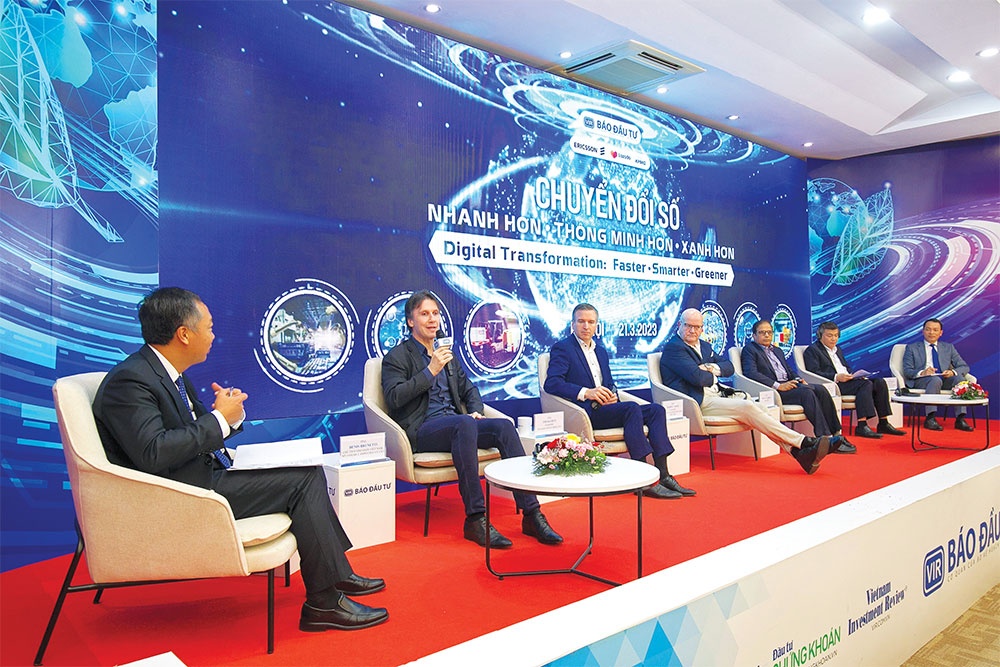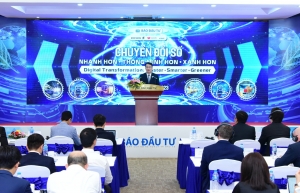Greener, faster, smarter digital plans
 |
| Great minds from around the world have a wealth of knowledge and want Vietnam to be a digital pioneer, Photo: Cuong Minh |
At VIR’s forum on digital transformation on March 21, Do Tien Thinh, deputy director of the Vietnam National Innovation Centre (NIC), said that it is crucial to support innovation and help businesses achieve their emission reduction goals.
“While technology groups seek to expand their customer base and provide tech solutions, local businesses require digital transformation and innovation,” Thinh said. “In response, the NIC acts as a mediator, connecting private sector businesses with technology solution providers to provide training for human resources in digital transformation and innovation.”
The NIC has already collaborated with the likes of Siemens, Google, and Hitachi to implement innovation support programmes at factories.
A very visible area of green digital transformation has been in manufacturing, with factories constantly seeking new approaches to automate and reduce emissions. According to Nestlé factory manager Urs Kloeti, Nestlé has achieved a reduction of CO2 emissions of up to 38,000 tons per year.
“Nestlé’s approach in Vietnam, as well as globally, is to look within technology development trends which enable us to save and/or gain growth opportunities. Through digitalising data, we were able to leverage our performance potential as well as sustainability opportunities,” Kloeti said.
E-commerce is another industry where digital transformation plays a vital role. Speaking of the urgent need to greenify the industry, Dang Anh Dung, deputy general director of Lazada Vietnam, said that its first decade in e-commerce had been spent investing in infrastructure, services, and technology. Entering the next era, e-commerce must add depth by promoting digital transformation towards sustainable growth.
“Users’ shopping behaviours have changed drastically. Businesses can contribute to sustainable e-commerce growth by developing sustainable business practices and using technology to deeply understand consumer behaviour,” Dung said. “A sustainable e-commerce ecosystem can be enhanced through supply chain and digital payment, and sustainable financial management to optimise and protect business assets.”
According to Dung, key sustainable business practices include advanced infrastructure development and high-quality digital talent development, focusing on employees with specific e-commerce skills.
Experts emphasise that in order for digitalisation to be effective, it must be integrated into every aspect of society. Progress being made at a steady pace gives confidence that the Vietnamese authorities are committed to promoting digital transformation and ensuring its successful implementation across various sectors.
Thinh of the NIC believes that public-private partnerships (PPPs) in innovation and digital transformation should go beyond specific projects, and that the state should play a crucial role in connecting business communities.
“Aside from assisting enterprises, the NIC also advises government agencies on policies, including its contribution to the Law on Investment two years ago. We suggested the provision of incentive mechanisms to encourage the adoption of innovation in businesses, particularly small- and medium-sized enterprises,” Thinh said.
“The concept of PPPs in innovation and digital transformation should not be confined to implementing specific projects. State parties should play a key role in connecting the business communities,” he added.
Drawing from experiences in Europe, David Lidén, trade commissioner of Sweden to Vietnam and country manager for Business Sweden, concluded that any kind of investment will come down to the payoff at the end of the day, so there needs to be a business case in place for a PPP to work.
“It’s wise to go into where demand is basically guaranteed. I think one of the things that we can bet on is that the demand for data and data transmission will keep increasing. Sometimes that might be slightly unprofitable, just like with energy in plenty of markets these days. But demand for energy and for data will not drop,” Lidén assessed.
He noted that in the process of digitalisation, countries should not get too caught up in having a grand master plan, as progress can be generated in many ways.
“What we can do top-down is make sure that the things that are guaranteed to increase in demand, like energy and data, are supported by infrastructure and standardisation. Clarity on standardisation and investments into infrastructure can be some of the initial steps that can’t go wrong,” he said.
| Tran Quoc Phuong-Deputy Minister of Planning and Investment
After some decades of rapid growth, Vietnam has been struggling with major challenges affecting its development such as the global economic downturn, which has slowed growth. The economy, based on cheap labour and natural resources, is not at a competitive advantage any more. There is also the risk of falling into the middle-income trap, and the ageing population to contend with. These challenges require Vietnam to find new growth models and engines for the economy. In this context, Vietnam has actively approached opportunities from the Fourth Industrial Revolution and the rapid development of digital technologies. The prime minister has approved the National Digital Transformation Programme, the National Strategy on the Fourth Industrial Revolution, and the E-government Development Strategy covering this decade and beyond. These efforts reaffirm the government’s determination to transform into a digital economy, which is an indispensable and objective requirement at a time when the whole world is witnessing rapid changes. In the process of formulating strategies and master plans for socioeconomic development, the Ministry of Planning and Investment (MPI) cooperates with ministries, branches, and localities to integrate tasks and solutions for Industry 4.0 and digital transformation to promote innovation in growth models. In order to support enterprises, since early 2021, the MPI has also proactively implemented the initiative to support businesses in digital transformation to 2025, to promote Vietnamese businesses to transform and adapt to the new context. The programme aims at transforming the awareness, vision, and strategy of enterprises; digitalising business activities, management, tech, and production processes; and supporting comprehensive digital transformation to create new products, services, and models for businesses. This programme has provided a wealth of knowledge and experience, and foundational tools over the past two years to help businesses move in the right direction, save time and costs, and improve the competitiveness of enterprises. In addition to the policy of promoting digital transformation towards a digital economy, the restructuring of the economy is associated with the renewal of the growth model in order to achieve economic prosperity, environmental sustainability, and social welfare. As Vietnam increasingly integrates into the global economy, businesses will have to be compliant with commitments on sustainable development and green growth that Vietnam has signed within various free trade agreements. This is a great pressure and challenge for Vietnamese businesses to be accepted by the market. In addition, the National Strategy on Green Growth for this decade with a vision to 2050 highlights the view of increasing green growth with oriented investment in advanced technology, digital transformation, and smart and sustainable infrastructure. This will be an impetus for private investment to play an increasingly important role in the green economy. The requirement for digital transformation and green growth is a major challenge for Vietnam and its businesses. Around the world, experts consider these as catalysts for many businesses to transform and adapt to green and sustainable models. |
| Nguyen Tien Huy - Director, Office for Sustainable Business Development Vietnam Chamber of Commerce and Industry | |
Examples include printing receipts – in 2019, it is anticipated that over 550 billion invoices were utilised in the US, of which only 10 per cent were electronic. This number will quadruple by 2030. This quantity of bills is mostly composed of planted wood. Using digital technology via the use of e-invoices reduces transportation costs and associated expenses, therefore lowering carbon emissions. Thus, organisations must begin implementing digital transformation, including green transformation – particularly when companies adopt environmental, social, and governance standards or when customers want greener, more responsible goods. In order to build a sustainable business model that will provide value to the economy, organisations must prepare for an environmentally friendly transition. Corporations have developed long-term strategic plans, a strong basis for applying digital transformation to their business models, and eco-friendly goods. Small- and medium-sized businesses are also not left behind. These firms are very dynamic. If they latch on to a trend, they will grow rapidly. They have successfully incorporated AI technology into manufacturing. The benefit of being a latecomer is that we have access to more advanced tech. In addition to the obstacles associated with the law, enterprises must also contend with the fact that their size is still modest. To create digital and green technology, they need an ecosystem, such as the leadership of the government or of significant corporations. | |
| Ngo Dien Hy-Deputy general director VNPT Group | |
On the flip side, the 5G concept is a little unconventional. We place a major emphasis on getting 5G up and running to deliver services to businesses. Thanks to its high speed and low latency, 5G will generate benefits for the expansion of manufacturing capabilities. Trials of 5G are also necessary to deliver tailored services in settings like an industrial park, factory, or seaport, all of which have various requirements in terms of data transfer rate, number of connected devices, and latency, among others. | |
| Bryan Carroll-CEO, TNEX | |
Due to the pandemic, digitalisation efforts have been cranked up to speeds 10-20 times faster than in prior years. It pushed traditional business models to become more innovative and digitally led, as digital channels were the only option for communication and engagement during that period. The driving force of the digitisation process is to satisfy customers’ ever-evolving demands, provide innovative user experiences, and add more meaningful value for them, which make their lives easier. In 2019, I came to Vietnam with the intention of establishing the country’s first carbon-neutral bank, with the goal of serving young people who have not had access to traditional banking services. Compared to the conventional banking approach, our annual carbon footprint is under 0.3 tons, which is a negligible amount, and we plant trees every year to offset this impact. |
 | Digital transformation: Faster - Smarter - Greener VIR's forum on Digital Transformation: Faster - Smarter - Greener on March 21 opened up new and practical information flows about dual transformation trends – digital and green – in the fields of manufacturing, finance and banking, and e-commerce and logistics. |
 | Powering smarter and greener industries Along with the deployment of 5G technology as a digitisation foundation, Vietnam has been setting up its infrastructure and human resources for a faster and greener digital transformation. |
What the stars mean:
★ Poor ★ ★ Promising ★★★ Good ★★★★ Very good ★★★★★ Exceptional
Themes: Digital Transformation
Related Contents
Latest News
More News
- Schaeffler reports strong early output from Dong Nai solar project (December 12, 2025 | 15:16)
- Forestry conference highlights biodiversity and sustainability goals (December 09, 2025 | 13:35)
- Home Credit honoured among top 10 sustainable companies in trade and services (December 09, 2025 | 12:18)
- SCG and seven member companies honoured in Top 100 Sustainable Businesses 2025 (December 08, 2025 | 09:00)
- Nestlé Vietnam pioneers sustainable development and promotes business connections (December 06, 2025 | 12:09)
- CSI 2025 highlights rise of Vietnam’s green champions (December 06, 2025 | 09:00)
- Acecook Vietnam named among top 100 sustainable businesses (December 06, 2025 | 08:00)
- Vietnam’s forest carbon credits draw global interest (December 05, 2025 | 17:41)
- Coro Energy to launch BESS Pilot in Vietnam (December 04, 2025 | 15:12)
- Vietnam strengthens energy storage pathway (December 04, 2025 | 15:05)





 Tag:
Tag:





















 Mobile Version
Mobile Version